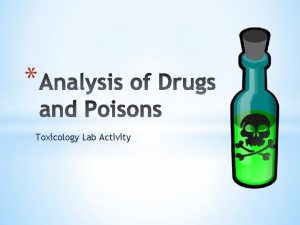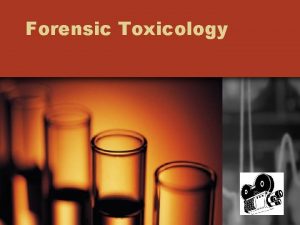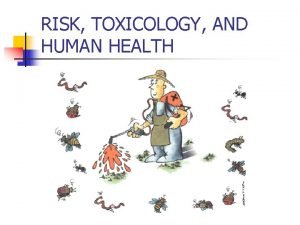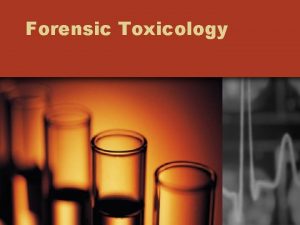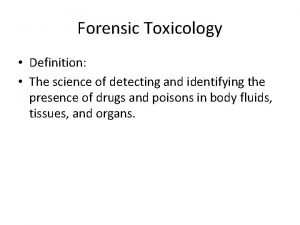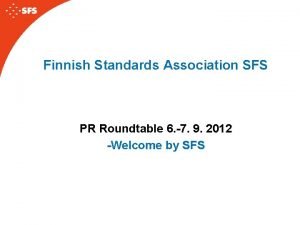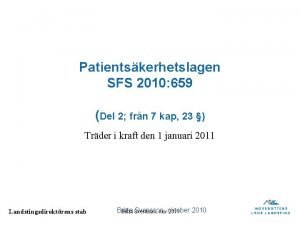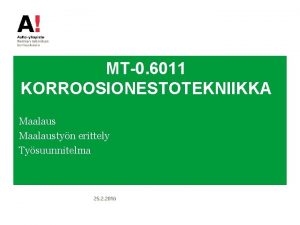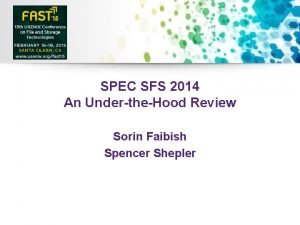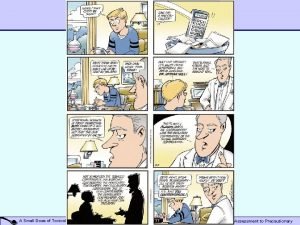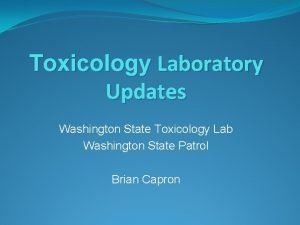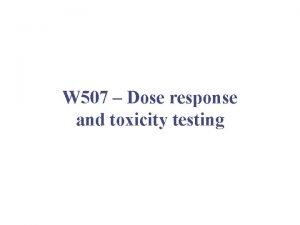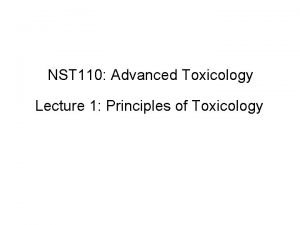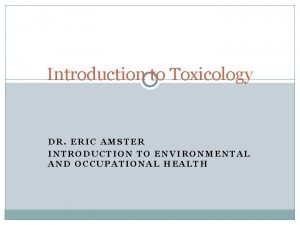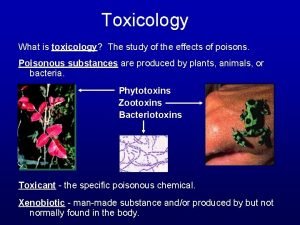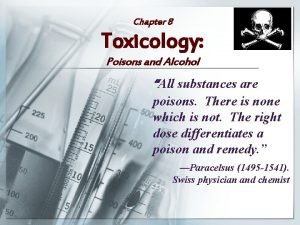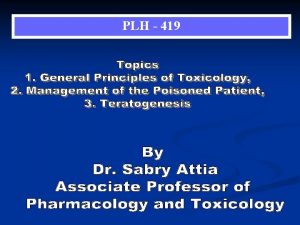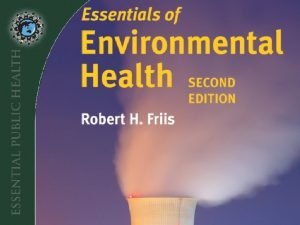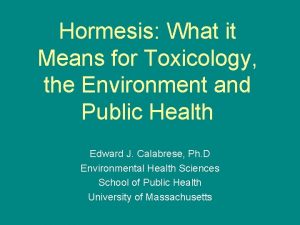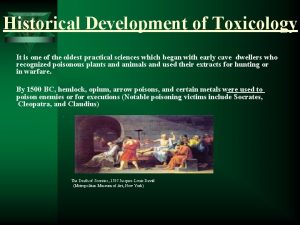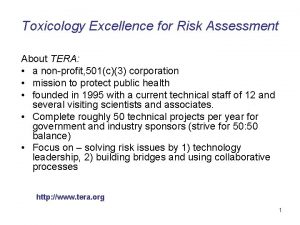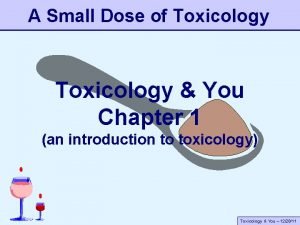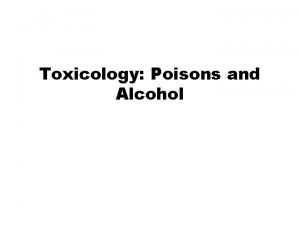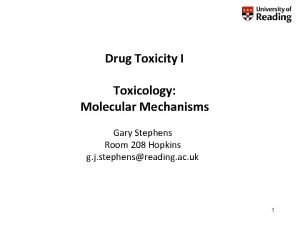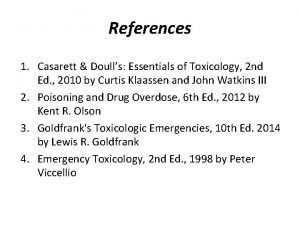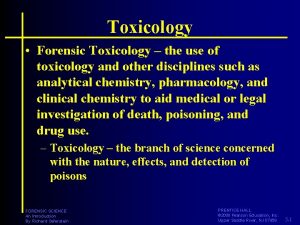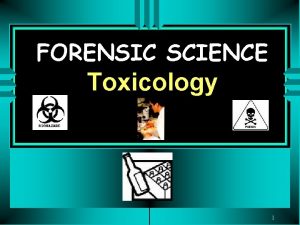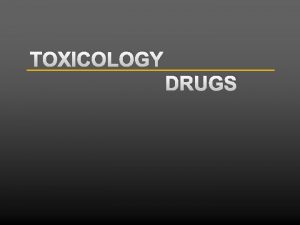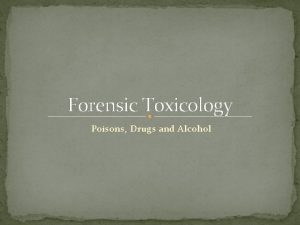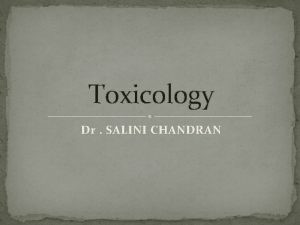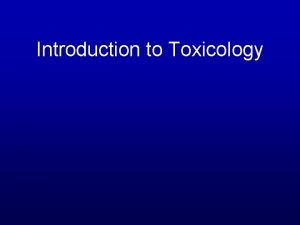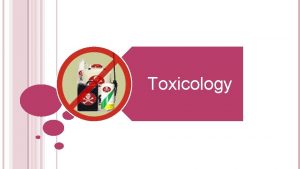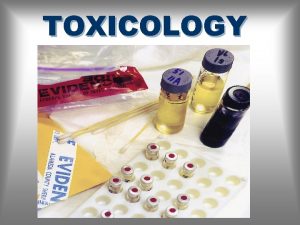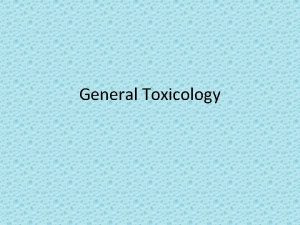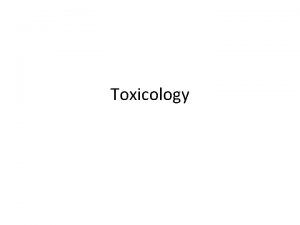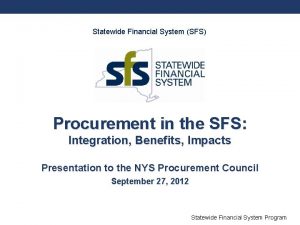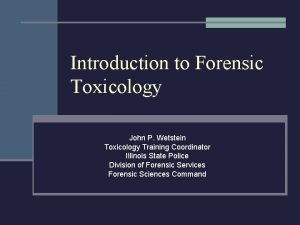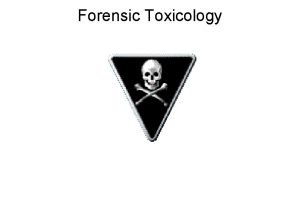Forensic Toxicology SFS 3 Students will analyze the




![History • Philippus Theophrastus Aureolus Bombastus von Hohenheim (aka Paracelsus [~1525]) observed that any History • Philippus Theophrastus Aureolus Bombastus von Hohenheim (aka Paracelsus [~1525]) observed that any](https://slidetodoc.com/presentation_image/45227b847a5f22a023051326a744a806/image-5.jpg)





















































- Slides: 58

Forensic Toxicology SFS 3. Students will analyze the use of toxicology…in forensic investigations. a. Classify toxins and their effects on the body. b. Compare the effects of alcohol on blood alcohol levels with regard to gender, and according to the law. c. Evaluate forensic techniques used to isolate toxins in the body.

ESSENTIAL QUESTIONS • How can you distinguish among the types of toxins and their effects on the body? • How are different forensic techniques used to isolate and identify toxins in the body? • What factors influence the effects of alcohol on the body and why?

Forensic toxicology is… • the use of detecting and identifying the presence of drugs and poisons in body fluids, tissues, and organs to aid medical or legal investigation. • The primary concern forensic toxicology is not the legal outcome of the toxicological investigation or the technology utilized, but rather the obtaining and interpreting of the results.

History • Earliest recorded use of poison was Socrates’ execution in 339 BC via ingestion of hemlock • In the Renaissance, poisoning became an art, occupation, even a hobby.
![History Philippus Theophrastus Aureolus Bombastus von Hohenheim aka Paracelsus 1525 observed that any History • Philippus Theophrastus Aureolus Bombastus von Hohenheim (aka Paracelsus [~1525]) observed that any](https://slidetodoc.com/presentation_image/45227b847a5f22a023051326a744a806/image-5.jpg)
History • Philippus Theophrastus Aureolus Bombastus von Hohenheim (aka Paracelsus [~1525]) observed that any substance could be a poison, depending on its dose: "All things are poison and nothing is without poison; only the dose makes a thing not a poison. "

History • Mathieu Orfila, chairman of the legal medicine department at La Sorbonne in France, published a book in 1814. • This was the first attempt to systematically study and classify poisons.

History • Orfila was the first to articulate the fact that poisons must be absorbed, or enter the blood, to manifest their effects.

History • In the U. S. , forensic toxicology did not develop until the early 20 th century in New York • Dr. Alexander Gettler (lead FT in NYC medical examiner lab) is considered this country’s first forensic toxicologist.

Poison vs. Toxin vs. Venom • Poison – substances that cause biological disturbance when absorbed in sufficient quantities – Toxin – produced biologically • Venom – injected via bite or sting Cyanide is poisonous Botulinum is toxic Rattlesnakes are venomous

Types of Poisons • Microbicide – used to reduce infectivity of microorganisms – chlorine, peroxide, antibiotics • Herbicide – used to kill unwanted plants – 2, 4 -D, atrazine, glyphosate (Roundup) • Pesticide – used to kill unwanted animals – DDT, pyrethrin, nicotine

Types of Toxins • Hemotoxin – destroy red blood cells – pit vipers • Necrotoxin – cause cell & tissue death – brown recluse spider, “flesh-eating bacteria” • Neurotoxin – affect the nervous system – Black widow spider, scorpions

Types of Venoms • Fang-released – snakes, centipedes, spiders • Sting-released – bees/wasps/ants, scorpions • Other methods – Hairs (caterpillars) – Tentacles (jellyfish) – Saliva (Gila monster) – Fins (lionfish, stingrays)

Toxicity • Dosage is indeed important, but so are… – The form of the substance • Insoluble vs. soluble – How it enters the body • Inhalation vs. injection vs. ingestion – Body weight/age/sex of victim

Toxicity – Time period of exposure • Acute vs. chronic toxicity – Interactions with other chemicals in the body • Synergistic vs. antagonistic

Toxicity • LD 50 – refers to amount of substance that would kill 50% of test population within 4 hrs. – Typically represented as (mg subst. / kg weight)

LD 50 information <1 mg/kg = taste to drop ~50 mg/kg = teaspoon ~500 mg/kg = ounce ~5000 mg/kg = pint Sugar - LD 50=29700 Caffeine - LD 50=192 Ethanol - LD 50=7060 Nicotine - LD 50=48 Salt - LD 50=3000 Cyanide - LD 50=6. 4 Botulinum toxin - LD 50=0. 00005

Roles of the Toxicologist • Must identify one of thousands of drugs and poisons • Must find nanogram to microgram quantities dissipated throughout the entire body • Not always looking for exact chemicals, but metabolites of desired chemicals (ex. heroin morphine within seconds)

Toxicology Procedures • Presumptive/Screening – quick test to narrow down possibilities – spot/color tests • Confirmation – determines exact identity – thin-layer/gas chromatography, IR spectroscopy, mass spectrometry

Presumptive/Screening • Marquis Test: – Turns purple in the presence of opiates – Turns orange-brown in presence of amphetamines • Scott Test: – Turns blue in the presence of cocaine • Duquenois-Levine: – Turns purple in the presence of tetrahydrocannabinal

Marquis Test

Scott Test

Duquenois-Levine

Confirmatory Tests • Microcrystalline Tests: Identifies drug by using chemicals that react to produce characteristic crystals • Chromatography: Separates drugs and gives tentative ID • Mass Spectrometry: Chemical “fingerprint” – no two drugs fragment the same • IR Spectroscopy: IR light is absorbed by different chemicals

Microcrystalline Tests

Chromatography

Mass Spectrometry

IR Spectroscopy

Testing Samples • Divided into 2 samples – 1 st sample is for screening test – 2 nd sample is for confirmatory test • Only done for samples that test positive during screening

Testing Samples • Blood – 10 m. L whole blood, anticoagulant, preservative – More expensive, but more accurate, can detect hours to days usage • Urine – Samples always given under direct supervision – Easy, cheap, can detect hours to days usage

Testing Samples • Hair samples – Collected from scalp or body – Can detect days to months usage • Saliva – Can detect hours to ~2 days usage • Vitreous humor – Only used post-mortem – Resists putrefaction, can detect usage after embalming

Governmental Regulatory Agencies • Food and Drug Administration • Environmental Protection Agency • Consumer Product Safety Commission • Department of Transportation • Occupational Safety and Health Administration

Controlled Substances Act • In 1970, federal law established 5 schedules of classification of controlled substances based on – Drug’s potential for abuse – Potential to physical and psychological dependence – Medical value • Federal law also controls materials that are used in making drugs and those that are manufactured to resemble drugs • DEA and FDA set classifications

Controlled Substances Act • Abuse – Inappropriate (misuse) or unwarranted use of substances, either legal (alcohol, prescriptions) or illegal

Controlled Substances Act • Dependence – Physical dependence occurs when the drug becomes necessary for the body to function normally. • Withdrawal symptoms can lead to abuse • NOT the same as addiction – Psychological dependence occurs when a person thinks they need a drug to function normally.

Drug Schedules • Schedule I: Drugs with high potential for abuse and addiction, NO medical value Ex: heroin, LSD, MDMA (Ecstasy), marijuana, GHB, peyote, psilocybin • Schedule II: Drugs with high potential for abuse and addiction, have some medical value with restrictions (no refills) Ex: PCP, cocaine, Ritalin, oxycodone, morphine, methamphetamine

Drug Schedules • Schedule III: Drugs with less potential for abuse and addiction, currently acceptable for medical use (no more than 6 refills) Ex: Vicodin, codeine, ketamine, anabolic steroids • Schedule IV: Drugs with low potential for abuse and addiction, currently acceptable for medical use (no more than 6 refills) Ex: Valium, Xanax, Rohypnol

Drug Schedules • Schedule V: Drugs with low potential abuse, lowest potential dependency, acceptable for medical use • Ex: antitussive, antidiarrheal, analgesic medicines


Classes of Drugs • Stimulant – Enhances the function or activity of the brain; causes alertness and motivation • Depressant – Relieves anxiety and muscle spasms; causes sedation and confusion • Hallucinogen – Causes subjective changes in perception, thought, emotion and consciousness • Narcotics (opioids) – Slowed physical activity, analgesia, drowsiness

Toxicology of Alcohol • Alcohol is absorbed through the stomach and intestine • Once absorbed, alcohol is: – Oxidized in liver by alcohol dehydrogenase—turned into acetic acid (vinegar) – Excreted by breath, perspiration, and kidneys—turned into carbon dioxide and water

Blood Alcohol Content • Relates amount of alcohol per volume of blood • Legal intoxication limit in US is 0. 08, meaning 0. 08 grams of ethanol per 100 m. L of blood (4. 5 -5. 5 m. L absorbed [~1 tsp]) >0. 20 – Stupor >0. 40 – Unconsciousness/death


Alcohol and the Law 1939 -1964: intoxicated = 0. 15% BAC 1965: intoxicated = 0. 10% BAC 2003: intoxicated = 0. 08% BAC At least we don’t live in France, Germany, Ireland, or Japan (0. 05%), Sweden or China (0. 02%), and Russia or Saudi Arabia (0. 00%)

Factors that Affect Alcohol Absorption • Amount consumed – More alcohol = more absorbed • Alcohol content – Maximum absorption with 20 -25% alcohol • Time of consumption – Maximum absorption with 30 minute consumption period

Factors that Affect Alcohol Absorption • Presence of food in stomach – Food in stomach slows absorption of alcohol • Body weight – More weight = more water in body to dilute alcohol • Gender – Females have more fat tissue = less water

Time of Consumption & Food in Stomach on BAC

Body Weight and Time of Consumption on BAC

Men vs. Women

Blood Alcohol Content • Measuring the quantity of alcohol in the blood system (BAC) determines the degree to which someone is intoxicated • Two methods of making this measurement – Measurement of alcohol content in blood – Measurement of alcohol in breath

BAC Testing • Blood alcohol is metabolized at the rate of 0. 015 per hr, so… – If your BAC is 0. 08, how long will it take for your BAC to be 0. 00? 0. 08 ÷ 0. 015 = 5. 33 hrs • Alcohol is identical to the BAC tester 1 can of beer = 1 glass of wine = 1 shot of liquor

Breath Tests • Evidence has shown that the ratio of alcohol in the blood to alcohol in alveoli air is approx. 2100 to 1—This is a basis for relating breath to blood -alcohol concentration. • One instrument used for breath tests is called The Breathalyzer.

The Breathalyzer

The Breathalyzer Con’t • The Breathalyzer traps 1/40 of 2100 milliliters of alveolar breath, so it, in essence, measures the alcohol concentration present in 1/40 of a milliliter of blood. • Developed in 1954, it was originally based on a color change observed by spectroscopy

Other Breath Tests • Infrared spectrophotometer technology • Electrochemical fuel cell technology These instruments are used more recently because they don’t depend upon chemical reagents and are entirely automated.

Infrared and Fuel Cell Breath Tests • Infrared Breath Test uses infrared wavelengths to test for alcohol or other interferences in the breath • Fuel Cell Test converts fuel (alcohol) and oxygen into a measurable electric current

Field Sobriety Testing • Two reasons for the field sobriety test: 1. Used as a preliminary test to ascertain the degree of the suspect’s physical impairment 2. To see whether or not an evidential test is justified

Field Sobriety Testing Methods • Field sobriety testing consists of a series of psychophysical tests and a preliminary breath test (typically done with a handheld fuel cell tester) • These tests are preliminary and nonevidential in nature—they only serve to establish probable cause requiring a more thorough breath or blood test

Field Sobriety Tests • Horizontal Gaze Nystagmus – Involuntary eye jerk as eye moves horizontally • Walk and Turn (divided attention tasks) • One-Leg Stand
 Forensic toxicology lab activity
Forensic toxicology lab activity Forensic toxicology definition
Forensic toxicology definition Forensic toxicology vocabulary
Forensic toxicology vocabulary History of toxicology slideshare
History of toxicology slideshare Forensic toxicology definition
Forensic toxicology definition Father of forensic serology
Father of forensic serology Thomas mocker and thomas stewart
Thomas mocker and thomas stewart Forensic psychiatry vs forensic psychology
Forensic psychiatry vs forensic psychology Hitsauksen laatu
Hitsauksen laatu Finnish standards association
Finnish standards association Jännitetyöalue pienjännitteellä
Jännitetyöalue pienjännitteellä Sma 805/2005
Sma 805/2005 Sfs 2010:659
Sfs 2010:659 Sfs 2213
Sfs 2213 Sfs-iso 14617-6
Sfs-iso 14617-6 Seguro sfs
Seguro sfs Waterloo fees arranged deadline
Waterloo fees arranged deadline Iskukoe
Iskukoe Babson sfs
Babson sfs Sfs car rental
Sfs car rental Pienahitsi merkintä
Pienahitsi merkintä 25
25 Cui sfs
Cui sfs Video spec
Video spec Pien- ja pienoisjännite sähköasennukset
Pien- ja pienoisjännite sähköasennukset Sfs significado
Sfs significado Surveying course of rizal
Surveying course of rizal Toxicology
Toxicology Washington state patrol toxicology lab
Washington state patrol toxicology lab Acute toxicity
Acute toxicity Ld50 examples
Ld50 examples Toxicology
Toxicology Toxicology is the study of
Toxicology is the study of Chapter 8 toxicology poisons and alcohol
Chapter 8 toxicology poisons and alcohol Chapter 21 toxicology
Chapter 21 toxicology Toxicology defination
Toxicology defination Toxicology definition
Toxicology definition Hormesis toxicology
Hormesis toxicology Examples of toxicology
Examples of toxicology Tera toxicology
Tera toxicology Chapter 8 toxicology test
Chapter 8 toxicology test A small dose of toxicology
A small dose of toxicology Accipitridae
Accipitridae Toxicology effects
Toxicology effects Toxicology and applied pharmacology
Toxicology and applied pharmacology Food safety and toxicology
Food safety and toxicology Therapeutic index
Therapeutic index Environmental toxicology definition
Environmental toxicology definition Toxicology management
Toxicology management Annual review of pharmacology and toxicology
Annual review of pharmacology and toxicology Toxicology effects
Toxicology effects North carolina medical examiner toxicology
North carolina medical examiner toxicology Drug identification and toxicology
Drug identification and toxicology điện thế nghỉ
điện thế nghỉ Một số thể thơ truyền thống
Một số thể thơ truyền thống Trời xanh đây là của chúng ta thể thơ
Trời xanh đây là của chúng ta thể thơ Lp html
Lp html Thế nào là số nguyên tố
Thế nào là số nguyên tố Tia chieu sa te
Tia chieu sa te
